Everyone’s comparing Expedition 33 to Final Fantasy because it’s the RPG they can name but really it’s Xenoblade Chronicles I feel all over this wonderful game. The narrative, the character relationships, the universe, the world-building, the way the narrative is delivered, the mystery
I’m reading Michael Crichton’s Jurassic Park in Spanish for the first time. Read it in English several times. I’ve only just realised that when the injured guy at the start says “lo sa raptor”, he isn’t trying to say something in Spanish. He’s literally trying to say velociraptor. Lo sa raptor
Scientists did not bring dire wolves back from extinction
Did Colossal Bioscience really bring dire wolves back from extinction? Absolutely not. Why not? And what did they do then?
If you’re anxiously awaiting the totally legit paper about the very real megastructures under the pyramids, why not read others from the researchers dn790003.ca.archive.org/0/items/C… (PDF)
Finally playing Monster Hunter Wilds today. A new MonHun for me is special. Like a new Zelda, Mario, or From Software game. Been in love with this series for 15 years and I love how it finally has a bigger audience
New mechanical build today. Put this one together for a gift. Fully automatic, no battery, specific Seiko dial because it was exactly the right shade and style I wanted for this. A quick, fun one! 💜

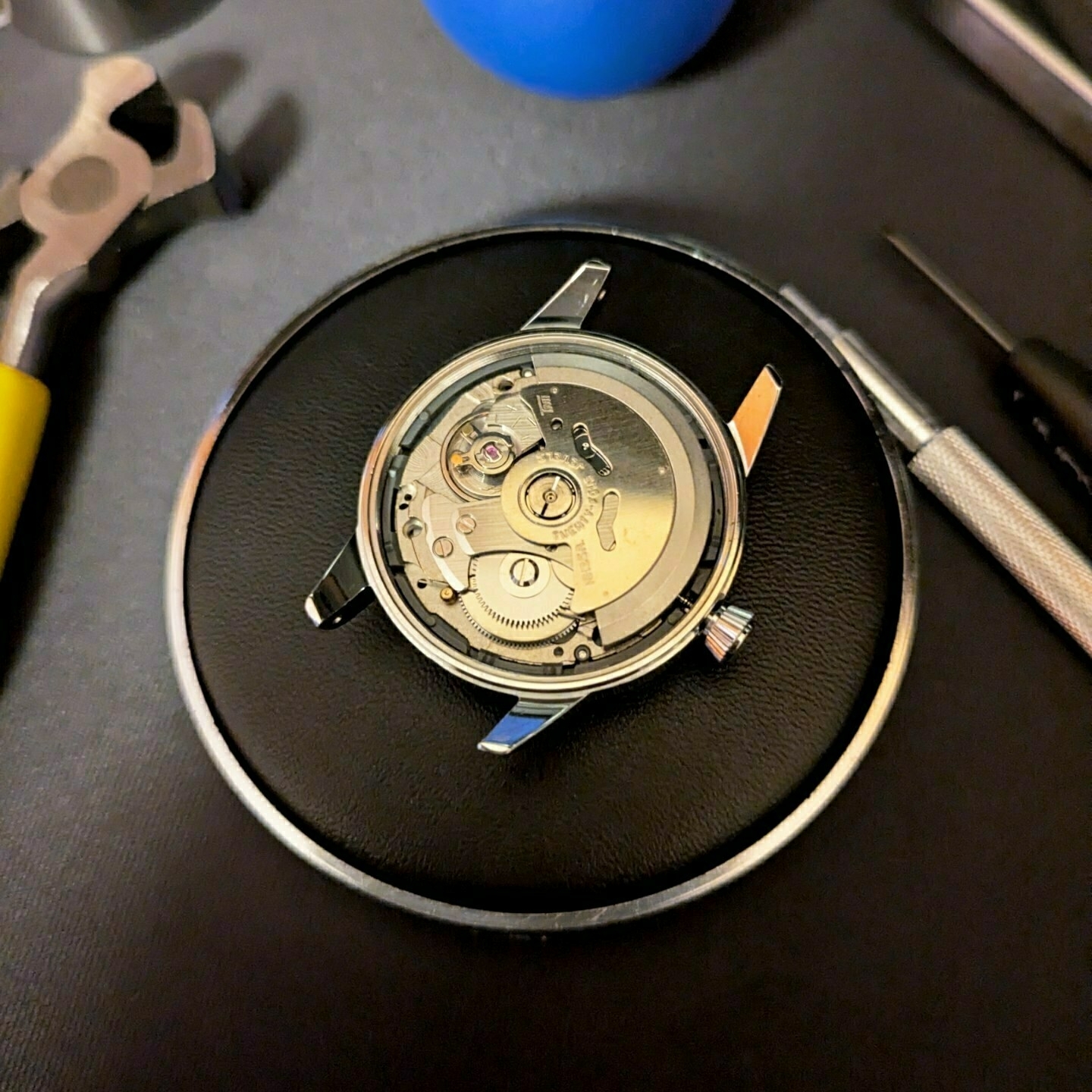
My friends scattered. I’m setting up a POSSE approach to posting. Publish (on your own site) Once, Syndicate Elsewhere. I’m writing this on my page and cross-posting elsewhere. IndieWeb has best practices for providing links and references back to the original content but I’m still figuring that out
Women in tech history: Hedy Lamarr — Hitler, Hollywood, and Wi-Fi 📽️
This is the sixth article in a series about amazing women in tech history. Previous entries have featured Margaret Hamilton, Grace Hopper, the ENIAC programmers, Katherine Johnson, and the women of Bletchley Park.
Today’s entry is a bit of an anomaly. We’ve covered some inspiring women in this series but most of them aren’t well-known to the general public. This is particularly true for the ENIAC programmers, who were forgotten for most of their lives; and the women of Bletchley Park, who had to keep their life-saving work secret for 30 years. Hedy Lamarr, on the other hand, was a household name in the western world. She was the highest-earning woman in Hollywood at the peak of her acting career and was often described as the most beautiful woman in the world.
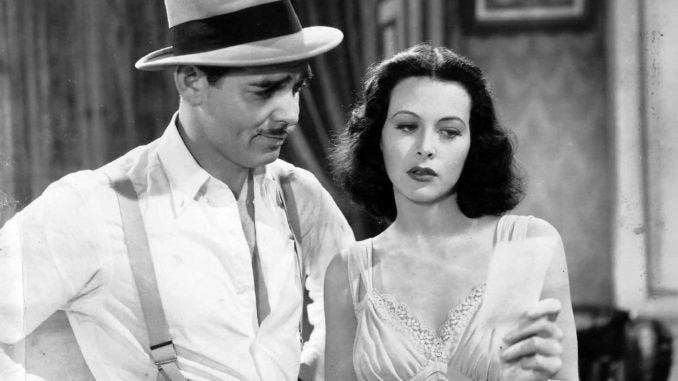
Photo: Publicity photo for Comrade X, public domain.
Lamarr got her biggest parts in movies because of her looks, which is something she regretted all her life. She became typecast for her glamour and was given few lines compared to the men she starred with. She had a creative and scientific mind and was described as someone who always came up with solutions to problems. Many people in her life didn’t actually know this about her because they made assumptions based on her appearance. Can someone be eye-candy and smart? The sexism of Hollywood drove her to be creative in other fields and she went on to invent technology that has almost certainly influenced your life.
Having Hitler for dinner
Hedy Lamarr was born Hedwig Eva Maria Kiesler in Vienna, Austria, in 1914. Lamarr began acting at a very young age and small parts in theatre productions as a child. She was eventually spotted as a teenager by German producer Max Reinhardt, who brought her to Germany to train in theatre but she soon entered the film industry. Lamarr was only 18 when she starred in Ecstasy, a controversial 1933 film where she played the ignored wife of a distant husband. This role made her famous in Austria but not necessarily for the best reasons. It was seen as controversial for showing such a young woman naked and faking orgasms.

Photo: Publicity photo for Comrade X, public domain.
In 1933, the same year that Ecstasy had brought her so much attention, Lamarr married one of the richest men in Austria: Friedrich Mandl, a munitions manufacturer and merchant. Although half-Jewish, he supplied weapons to Mussolini and had close connections with the Nazis. Together they lived in a huge castle and held parties there with the likes of Mussolini and Hitler. Even by the age of 18 her life was far from ordinary.
According to Lamarr, Mandl was a jealous, controlling man and didn’t want her to continue acting for fear she would star in something like Ecstasy again. She was kept in the castle and described feeling like a prisoner. Most of her social interaction was with fascists as she was forced to accompany Mandl to his business meetings. This was a difficult time for Lamarr but there was a positive to take from it all. Many of the meetings were with military scientists discussing advanced technologies and it fascinated her. This was when she began to focus some of her time and resources in science and apply her natural creativity to fix real problems.
The escape
In 1937 Lamarr couldn’t live in that castle any longer but was sure Mandl wouldn’t allow her to leave. According to her autobiography, she disguised herself as a maid and sneaked out. She didn’t just want out of the castle, she wanted to be as far away as possible. She made her way to Paris where she met MGM head Louis B. Mayer, who was scouting for foreign talent. He convinced her to come with him to America to star in Hollywood films.
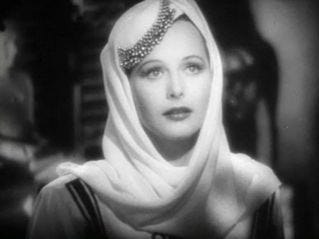
Photo: Hedy Lamarr in Lady of the Tropics. Trailer screenshot, public domain.
From 1938 to the late 1950s Lamarr dominated Hollywood. Much to her displeasure in later life, she wasn’t necessarily loved for her acting abilities or personality but for her looks alone. She was seen by many as the world’s most beautiful woman and the marketing directors recognised this so they played into it. Her foreign accent and mysterious stage name only added to the image that made her the pin-up of choice for many soldiers fighting abroad.
Lamarr seemed to have it all. She was rich, famous, and admired. But in many ways she was still a prisoner. Much like she felt trapped by Mandl and his castle, Hollywood trapped her because of her looks. She was increasingly given roles that were highly sexual with very few spoken lines. She became typecast in such a way that she appeared to many as a face rather than a person. She obviously knew there was more to her than eye-candy and this attitude sometimes caused problems with executives.
I was the highest-priced and most important star in Hollywood, but I was “difficult.”
She grew bored and needed another outlet for her creativity. With World War II on everyone’s mind and exciting technological advances happening at the same time, her interest in science was stronger than ever. She wasn’t given the freedom to invent anything on screen so she took to inventing things in the real world.
Frequency-hopping
Lamarr spent years working on inventions, many of which were successful in the fact that they worked but didn’t necessarily go anywhere commercially. These includes improved traffic lights, improved tissue boxes, and even a pill that turned water into a carbonated beverage. She had been interested in torpedoes and radio technologies since her time in Mandl’s castle, hearing scientists talk about the weapons on Nazi U-boats. During World War II, she turned her attention to inventions that could help in the fight.
She knew from those meetings that remote controlled torpedoes weren’t a good option because radio-jamming could protect Nazi boats. As long as you knew the frequency, you could disrupt the signal to the torpedo. She puzzled over ways to protect torpedoes and hit upon a solution when she met the film composer George Antheil. He used strange instruments and arrangements in his music and liked to tinker and invent much as Lamarr did. She was inspired by his use of multiple pianos roles to move music from one piano to another without missing a beat.
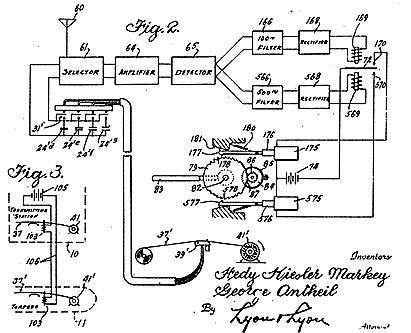
Image: A figure from the 1942 patent. Via Flickr/Floor, distributed under a CC BY-SA 2.0 license.
Together, they successful patented a genius technology, frequency-hopping spread spectrum (FHSS), which would use the piano roll to protect radiowaves from being jammed. Just as the music could transfer from one piano to another by carefully synchronising the piano rolls, radio signals could be switched to other channels using the same method. By doing these switches in a pseudorandom order known only by the transmitter and receiver, it would be impossible for the Nazis to jam or read the signal. At best they could jam one frequency but the torpedo would only be out of communications briefly until the next frequency hop.
The patent was made on 11 August, 1942, but the Navy turned it down. They didn’t fully appreciate its value, the technology would be difficult to implement, and they were reluctant to use patents that didn’t come from within the military. In the 1950s the technology was taken by engineers at Sylvania Electronics Systems Division for in military communications and by the 1960s an upgraded version was indeed being used to control torpedoes.
It’s all around us
Frequency-hopping spread spectrum is one of the most important aspects of Code division multiple access (CDMA), which is in many technologies we use today. One of its first is in GPS, which you use every time you check your location in your smartphone’s maps app. Mobile phones also used CDMA for phone signals and if you’ve ever downloaded something over a 3G network you were using technology built around Lamarr and Antheil’s invention. With frequency-hopping spread spectrum technology being all around us, it’s easy to take it for granted, but the invention should be admired and respected for being so creative and ingenious.
Despite the work influencing so much technology that dominates our lives, they never received much recognition for the work. Lamarr didn’t receive any money for the use of her patent by the Navy or by phone companies. Like many of the women in tech history we’ve written about, Lamarr was largely ignored for most of her life when it came to science and technology. Now there are a few books about her life and movements to get her recognised. The latest project was a documentary about her life to be filmed by Reframed Pictures. Here’s Susan Sarandon talking about the project:
People started to make the connection between the Hollywood superstar and frequency-hopping in the 1990s. In 1997 she finally received recognition for her work when the the Electronic Frontier Foundation gave her the Pioneer Award. According to her biographer Richard Rhodes:
When they called her up to tell her she would get the award her first words were, Hedy Lamarr being Hedy Lamarr, “Well, it’s about time.”
Lamarr was in her 80s when she received this recognition then died shortly after of heart failure in 2000. In 2014 both co-inventors of the technology were inducted into the US National Inventors Hall of Fame.
Scared money
Lamarr didn’t think she was necessarily smarter than people around her. Instead, it was her attitude that set her apart. She asked questions. She wanted to improve things. She saw problems and knew they didn’t have to be problems. Some people in her life saw it as the wrong attitude and she was often criticised for being a difficult star. But Lamarr was doing exactly what she wanted to do so was clearly winning. And how did she win? As she said in Popcorn in Paradise:
I win because I learned years ago that scared money always loses. I never care, so I win.
“Scared money” refers to being so afraid of losing that it impairs your decision-making and makes it more likely that you will lose. Lamarr was able to let that go. She had the world’s eyes on her just waiting for a mistake yet she made it in Hollywood and when that didn’t appeal anymore she contributed to technology you’re likely using while reading this. She was beautiful, smart and talented but none of that guaranteed success in male-dominated fields. What mattered most was that she wasn’t afraid.
Lamarr faced sexism like all the women in this series but in arguably more unusual circumstances. She wasn’t just a woman in tech; she was also a superstar admired for her beauty. According to Lamarr, this meant she faced two very different sides of misogyny. Some people assumed, from looks alone, that she wasn’t smart. Others assumed that if she was smart then it was a negative aspect of her personality. Her smarts were likely a devious, deceptive, untrustworthy intelligence and this was a problem rarely said about attractive male leads. Sometimes you just can’t win, except she eventually did. She won because scared money always loses and she wasn’t afraid to be herself.
This is the sixth article in a series about amazing women in tech history. Previous entries have featured Margaret Hamilton, Grace Hopper, the ENIAC programmers, Katherine Johnson, and the women of Bletchley Park.
Women in tech history: Bletchley Park
This is the fifth article in a series about amazing women in tech history. Here we look at the women of Bletchley Park who saved many lives during World War II.
The difference between “homeobox” and “Hox” genes
This is a big pet peeve: the terms “homeobox” and “Hox” are not interchangeable. They mean different things. I’m correct in saying that Amphioxus (Branchiostoma lanceolatum) has 15 Hox genes but I’m also correct in pointing out that it has over 130 homeobox genes.
Gene names can be very confusing and difficult to remember, so there are many abbreviations and acronyms in biology. For example, the gene insulin-like growth factor 1 is abbreviated to Igf1. I don’t know if that makes it easier to remember but it certainly makes it easier to write about! I believe the use of abbreviations is partly responsible for the incredible confusion over homeobox and Hox genes, and I do mean incredible.
It’s obviously a confusing topic for students, or anyone new to evo-devo, developmental genetics, or gene regulation… but it’s so much worse than that. Science communicators make the mistake, professional publications make the mistake, academics make the mistake and they do it often. I think the reason it keeps happening is that the word “Hox” appears to be a shortened “Homeobox”. All over the internet you will see the terms used interchangeably, and sometimes with the apparently shortened version in brackets: “Homeobox (Hox)”. This otherwise decent glossary at Epigenesys manages to dump the terms homeotic, homeobox, and Hox into one single paragraph and glossary entry, which is of little help to a confused student seeking clarity.
If you’re a student you may have watched science videos by YouTubers like Hank Green and seen the same “Homeobox (Hox)” terminology and the two words being used interchangeably. The first Google result for “homeodomain” (ignoring Wikipedia) is R&D Systems saying, “The DNA sequence that encodes the homeodomain is called the homeobox and homeobox-containing genes are known as hox genes”. This is wrong. A homeobox-containing gene is not necessarily a Hox gene. So let’s clear this up.
First, let’s go over the facts, and what the real difference is, before we discuss why these confusing names have been chosen. Scientists discovered that there are some genes that contain a very conserved region of DNA we now call the homeobox. When I say very conserved, I really mean it. You have homeobox genes, the birds outside do, the grass outside does… even yeast does. The origin of homeobox genes is truly ancient, definitely pre-dating the origin of animals. The 180-base-pair homeobox codes for a 60-residue chain known as the homeobox domain (or homeodomain). In plain English: the region of the gene is known as a homeobox and the region of the resulting protein is the homeodomain. The explanation for why it is so conserved across organisms, through hundreds of millions of years of evolution, is that its function restricts its evolution. The homeobox domain binds DNA (or RNA), allowing a protein with a homeodomain to act in gene regulation. For example, these proteins can be used to turn genes on and off during development. It’s an invention of evolution that’s persisted through the origin of the fungi, plants, and us animals, and the homeobox itself hasn’t changed much at all. So there’s your definition of a “homeobox gene”. It isn’t a specific gene, it’s a huge and ancient group of genes that all contain the homeobox, a region of DNA that codes for a domain which can bind to DNA.
Every Hox gene is a homeobox gene, but not every homeobox gene is a Hox gene. The homeobox genes have diversified so much through evolutionary history that there are now distinct classes of them. The most famous is definitely the family of Hox genes. The terms make sense when you consider their history. When scientists first discovered the homeobox domain, they found it because they happened to be studying animals that had mutated Hox genes. These mutants often had body parts in the wrong place, and were described as “homeotic mutants”. When they identified the genes causing the mutations, they discovered that they all shared a common motif, so they named it the homeobox. This is one of the most incredible discoveries in biology, as they quickly realised that the homeobox is found in genes from humans, flies, jellyfish, daffodils, yeast, and so on. However, the actual genes they had discovered were a distinct group of homeobox genes, which we now call the Hox genes. They definitely are homeobox genes, and they regulate other genes.
Think about the confusion here. Hox genes are a distinct family of homeobox genes. Scientists discovered the homeobox motif by investigating which genes caused homeotic mutations. What they had found were the Hox genes so calling the Hox genes homeotic is fine, that’s the effect they have. However, they didn’t understand at the time that the homeobox motif is found in many genes that aren’t Hox genes. Many homeobox genes have absolutely nothing to do with body parts growing in the right or wrong places but when they named the homeobox, they only knew of the Hox genes they were discovering via the homeotic mutants. This is where almost all the confusion stems from. Despite homeobox genes in general having “homeo” in their name, most don’t cause homeotic mutants if modified. The Hox genes, a specific family of homeobox genes, are great examples of genes that can cause homeotic mutants.
In us bilaterian animals, one of the main roles of the Hox genes is to specify anteroposterior identity to your body. It’s a complicated system, but we’ll keep it simple. The Hox genes play a role in determining which body parts grow where on the body. So by messing with them you can make limbs grow in the wrong places. But as I’ve mentioned there are plenty of other non-Hox homeobox genes. There are entirely different families with entirely different roles. The Hox genes control the body plan along the anterior to posterior axis in us bilaterian animals, but there’s still some uncertainty over their precise role in non-bilaterian animals. The Hox genes do appear to be unique to animals and don’t find them in plants and fungi. Of course you still find they have other homeobox genes, just not the Hox genes, which appear to have arisen very early in animal evolution (there is evidence that sponges had Hox genes too, but have since lost them).
We know so much about homeobox genes, especially the Hox cluster, that we could discuss it all day. The evolution of the Hox, ParaHox, and NK clusters is quite fascinating, as are the roles of these gene families in a developing animal. Understanding the interplay between development and evolution can provide unique insight into both, which is incredibly exciting so do not be put off by the unfortunate naming conventions and mistakes made by others. To summarise: Hox genes are homeobox genes as they contain the homeobox, but homeobox genes include Hox genes, ParaHox genes, NK genes etc. The terms are not interchangeable. It’s such an easy mistake to make that it appears in books, academic websites, and helpful videos on YouTube. Just keep it in mind and focus on what exactly is being discussed. It’s not necessarily wrong to describe a mobile phone as technology, but the terms aren’t interchangeable. You can’t go around describing technology as mobile phones. It makes no sense to say, “the electron microscope is a wonderful mobile phone”. Homeobox and Hox genes work the same way. You can describe a Hox gene as a homeobox gene because that’s exactly what it is. Just note that the terms aren’t interchangeable.
Women in tech history: Katherine Johnson, the mathematician who guided us to the moon 🚀
This is the fourth article in a series about amazing women in tech history. The first featured Margaret Hamilton, the software engineer who helped land us on the moon. The second featured Grace Hopper, a programming pioneer and first woman to be a US Navy Admiral. The third featured the ENIAC programmers, who were pioneers ignored by history.
The women featured so far in this series have been white Americans. There are many more stories to tell and upcoming articles will feature women here in the UK and elsewhere abroad. For now we turn our attention to Katherine Johnson, an amazing woman who faced both gender and racial discrimination in pursuit of her passion. I chose to focus on Katherine in this article because I wonder how many people know that the trajectory for NASA’s first manned mission was calculated by an African American woman.
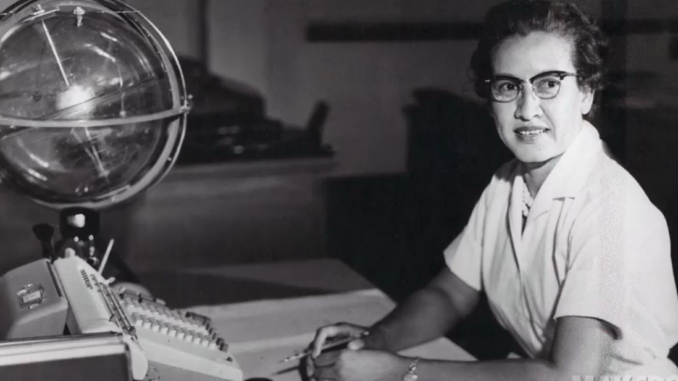
Photo: NASA
Katherine was born in August 26, 1918, which happens to be Women’s Equality Day in the US. Her family lived in West Virginia, where her father was a farmer and part-time janitor. Her mother was a teacher before having 4 children of which Katherine was the youngest. It was clear from a very young age that maths would become a huge part of Katherine’s life.
“I counted everything. I counted the steps to the road, the steps up to church, the number of dishes and silverware I washed… anything that could be counted, I did.”
Her father was desperate to get his children a decent education but had little choice at home; the local school wouldn’t teach African Americans beyond 8th grade. He had to send them to a school 125 miles away from their home. Teachers at the school were amazed at Katherine’s abilities not just with numbers but her reading skills. When she started school she skipped straight to 2nd grade and then later skipped 5th grade meaning she was a grade above some of her older siblings. This acceleration meant she started high school at the age of 10.
Towards the end of high school, Katherine was taught by Schiefflin Clayton who only the 3rd African American to earn a PhD in maths. He instantly recognised Katherine’s talents and love for astronomy. He created entire courses at the school just for Katherine, including analytic geometry, and she was usually the only pupil in these lessons. She finished high school and started college at the age of 14 and had completed a Bachelor of Science degree in maths and French by the time she was 18.
The height of segregation
Katherine wasn’t oblivious to racism growing up but hadn’t experienced the worst of it until she began working. Her first job was as a teacher but she had to travel to Virgina. Her mother warned her that things were worse there than in West Virginia and that she should be careful. Katherine responded, “Well, tell them I’m coming.”
Katherine’s story is one of personal strength. She once told NASA administrator Charles Boldon that she didn’t care too much about racism in her own life. “I didn’t have time for that… don’t have a feeling of inferiority. Never had. I’m as good as anybody, but no better.” Katherine grew up when segregation in the US was at its worst but it wasn’t something that could stop her doing what she wanted to do. She braved the segregated bus commutes and worked as a teacher for several years.
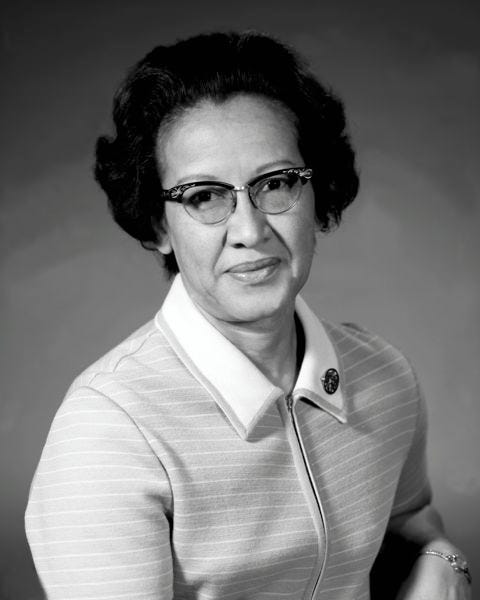
NASA
During World War II, there were shortages for scientists and engineers as many were fighting overseas. This led to the hiring of women mathematicians for important roles during the war. In 1941, Franklin D. Roosevelt signed an order to begin hiring more African Americans too. Two years later, the Langley Research Centre began hiring African American women who studied maths and chemistry to work as “human computers” in a research lab. In 1953, Katherine joined the women at Langley working for NACA, which would become NASA. Katherine didn’t escape racism by joining NASA; the employees were segregated and the reminders were always there. The lab itself was built over a former plantation.
Katherine was not alone when she joined; dozens of African American women worked at Langley as human computers, doing extremely complex calculations for a number of projects in the space race. The job paid better than many alternatives for educated women at the time ($2000 per year) but they were still discriminated against. At the research lab, the women were segregated in “coloured” work-spaces separate from the white women doing the exact same work. They were made to work a mile away from the other women and in facilities that didn’t even have a toilet. The white women were given accommodation nearby while Katherine and her colleagues had to make their own arrangements.
It’s important to note that although this is a story about the life of Katherine Johnson, many African American women contributed to NASA’s space programme as human computers. Most of the complex calculations required by the agency were provided by women and Katherine famously described this as a time when “the computer wore a skirt.” We celebrate the white men who landed on the moon, and rightly so, but rarely the countless women that helped make it happen. Many of those women were African Americans working during the height of segregation. They did their jobs well and helped NASA work with trajectories, analyse data from wind resistance tests, and figure out how spacecraft could re-enter the Earth’s atmosphere without burning up.
One small step
Katherine was respected for her calculations and was a prized member of her team. What made her stand out from everyone else was her questioning attitude. Others did what they were told but Katherine always needed to know more. When she was given new trajectories she would ask what they were for; she asked technical questions about the missions; she asked why the women were never invited to the meetings. It wasn’t long before she caught the eye of her supervisors.
One day she was taken into an all-male group temporarily to assist with calculations. She showed her expertise, asked questions, and they apparently “forgot” to send her back to the other women. She never looked back. Her expertise was calculating the trajectories of launches and where they would land.
“I’d ask ‘where do you want to come down?’ And they’d tell me the spot and I’d work backward form there.”
She was there for the Mercury missions in the 1950s-60s, the Apollo missions in the 1960s-70s, and the space shuttle missions in the 1980s. Her trajectories were used in many of NASA’s most historic achievements.

Photo: NASA/Sean Smith
In 1961, Alan Shephard became the first American in space (he’s also famous for hitting a golf ball on the moon) and Katherine calculated the trajectories to get him up there and safely back to Earth. Launches are complicated enough, taking into account things like weather conditions, but soon NASA had her working with orbits too. The following year, John Glenn was to become the first American to orbit the planet and again Katherine was behind the trajectories. For that mission NASA had started using computers for the first time but Katherine’s own calculations were still used to verify that the computers were accurate. The move to computers led to Katherine becoming a computer scientist as well as mathematician.
Katherine was a technical leader during the Apollo missions and played a pivotal role in America’s successful space race. Perhaps her greatest contribution was calculating the trajectories for Apollo 11, the mission that landed humans on the moon for the first time.
“I felt most proud of the success of the Apollo mission. They were going to the moon and I computed the path to get there.”
Later life
Katherine worked on space shuttle and satellite missions before finally retiring in 1986 after 33 years with NASA. During her career she was instrumental in many firsts including the moon landing but also contributed to NASA in more subtle ways. She created space textbooks for the agency; she created star maps that would allow astronauts to pilot themselves home in the event of electronics failures; she co-authored 26 scientific publications; she even contributed work for future missions to Mars.
In retirement, Katherine has been an incredible inspiration to young people and not just because of her past achievements. She has spent decades working with young people to encourage them to take up STEM careers. Over the years her efforts in the space race and in encouraging young people to take up STEM subjects has won her many awards and honorary degrees from universities. Last November, at the age of 97, President Obama awarded Katherine with America’s highest civilian honour: the Presidential Medal of Freedom.

Photo: NASA
Katherine is an inspiration to anyone with a passion. There were many forces in her life that made it difficult to pursue her passion but she overcame them all, including gender discrimination and racial segregation. She didn’t just keep her head down and do the work society expected her to; she wanted to work in a male-dominated field during a time of racial segregation in the US. Katherine believed that she was as good as anyone, “but no better.” Those who worked with her claim she was definitely better. NASA owes Katherine Johnson so much and she will always be a key figure in the history of space exploration.
This is the fourth article in a series about amazing women in tech history. The first featured Margaret Hamilton, the programming pioneer who helped land us on the moon. The second featured Grace Hopper, the programming pioneer who became the first woman to be a US Navy Admiral. The third featured the ENIAC programmers who were pioneers ignored by history. The next is about the women of Bletchley Park, who saved countless lives in WWII but were sworn to secrecy.
Women in tech history: ENIAC and the programming pioneers that nobody knew
This is the third article in a series about amazing women in tech history. The first featured Margaret Hamilton, the programming pioneer who helped land us on the moon. The second featured Grace Hopper, the programming pioneer who became the first woman to be a US Navy Admiral.
In 1946, after World War II had ended, the US Army finally unveiled a top secret project to the public: ENIAC, the first general purpose, all-electronic computer. It was a game-changer. The press called it the “Giant Brain” and dreamed up fantastical futures where we all could have electronic computers in our lives. The designers, John Mauchly and John Presper Eckert, were celebrated for their achievement and rightly so; it was a marvel of engineering. It was designed to calculate ballistics for artillery but was also involved in calculations for the first hydrogen bombs.
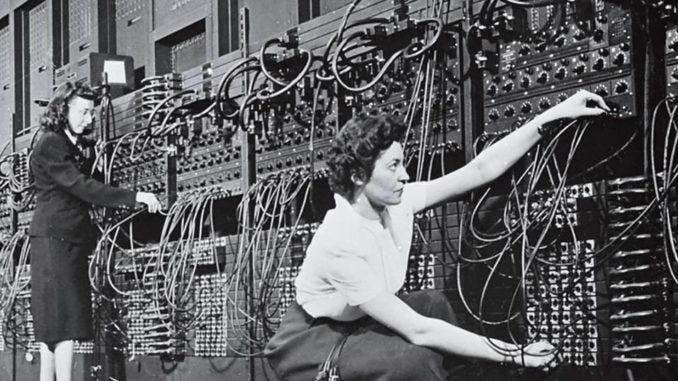
Photo: University of Pennsylvania
In the 1980s, 40 years after the top secret computer was made public, a programmer named Kathy Kleiman asked a fascinating question: who are the women in nearly every photo of the ENIAC computer? They look busy. They’re changing cables and turning switches. What was their involvement in the project? The photos were taken at the public unveiling but the women there weren’t actually introduced. The world had no idea who they were, which is a shame because they were the first programmers of the all-electronic computer.
Ballistics

During World War II, long range canons struggled to hit targets that were miles away because the weather affected the trajectory of the missile fired. Using complex equations, which could be modified for different environmental conditions, the accuracy of weapons could be improved. Gunners would look at “firing tables”, which told them where to aim to get the range they were looking for given a specific condition.
The horrifically complex equations were a nightmare. For every possible range of every weapon, they needed to calculate different angles that took everything else into account including temperature and humidity. The equations were so difficult that it took experts days to calculate a single trajectory. This clearly wasn’t something that gunners could calculate on the spot. Instead, the firing tables would need to be calculated by huge teams in order to keep up with the demand.
The problem was that most men with mathematics degrees were fighting overseas or involved in other areas of research such as Project Manhattan. In 1942, the US Army decided to turn to women and put out ads in newspapers looking for maths graduates to work on these calculations at the University of Pennsylvania.
Human “computors”
Betty Holberton was a keen student with a passion for mathematics when she arrived at the University of Pennsylvania to begin a maths degree. On the very first day, her maths professor suggested that her time would be better spent at home raising children. She decided to study journalism instead, since it would allow her to travel, but soon came back to maths when she was hired by the university’s Moore School of Engineering as a “computor”: literally a person that does computations.
Over 100 women were brought in to do the computations necessary for long range weapons to be fired effectively in the war. They each worked with just a pen, paper, and a calculator. It took around 40 hours to do a single trajectory; some of the more difficult ones took a week. The women worked well but simply couldn’t keep up with the machinery of war. The Army needed firing tables faster than the women could calculate them and some guns sat unused. Human computers were too slow.
ENIAC
Funded by the US Army and built by Moore’s School of Engineering, a top-secret computer was built codenamed “Project PX” but would later come to be called ENIAC (Electronic Numerical Integrator And Computer). It was an experimental long shot but it was hoped that the first general purpose, all-electronic computer could drastically improve the speed of trajectory calculations for the firing tables.
The women working on the calculations by hand had no idea about the project. The computer cost $500,000 at a time when the women were making $2000 a year. It worked, it was an engineering marvel, but it couldn’t do anything useful by itself. It was all hardware back then and had to be told what to do. It might be hard to imagine how primitive this computer was but realise that we’re not even talking about punching holes into cards here. Making the computer do something involved using 3,000 switches, 18,000 vacuum tubes, and hundreds of cables. It was 100 ft long and stood 8 ft tall. Different units could do different functions and store a 10-digit number to be passed to the next unit. It seems very alien compared to what we have today.
What ENIAC needed were programmers. They needed to be maths experts who knew the trajectory calculations but they also needed to know how to program the ENIAC. Unfortunately, nobody really knew how to program it. Whoever started would be the first. Of the 100 or so women currently “computing” by hand, 6 were chosen to work on ENIAC. They were Jean Bartik, Kathleen Antonelli, Marlyn Meltzer, Frances Spense, Ruth Teitelbaum, and Betty Holberton who had been told to stay at home to raise children.
Programmers
The challenge that the ENIAC women faced cannot be overstated. Absurdly, they weren’t allowed to see the computer since it was still top secret. Instead, they were given the circuit diagrams and blueprints for the machine and told to teach themselves how it worked. They had to figure out how to program the first general purpose electronic computer purely by studying the inner workings of the machine. Think about how challenging this would have been the next time you struggle with IKEA instructions.
“They had no books or anything to teach us how to program it.” — Jean Bartik

Photo: University of Pennsylvania
Our modern computers do the hard work and we just tell them what to do. Modern computers didn’t appear overnight but gradually evolved so there was a transition between people doing all the computations and computers doing them. The ENIAC was an intermediate, almost like a biological computer with the women as components in the system. The ENIAC couldn’t store software. Instead, the women and the computer worked together as one. The women did the calculations, determined how to have the ENIAC compute the given problems, and then programmed the 1000 kg machine by moving cables around and turning the 3000 different dials. The women said it was difficult, that it was a nightmare at times, and that they loved every moment of it.
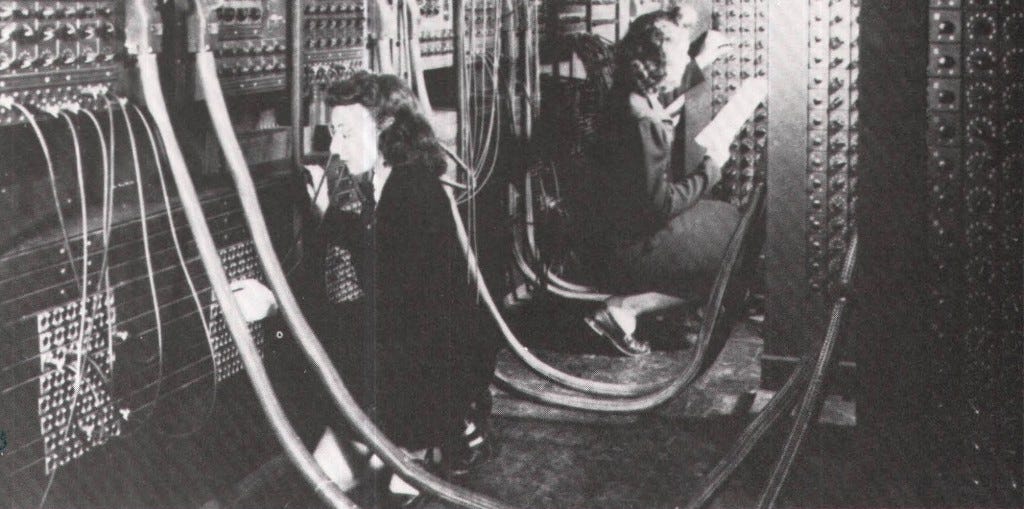
Photo: University of Pennsylvania
They did it. The programmers got the computer calculating a month’s worth of trajectories in a day. They even performed calculations for the feasibility of thermonuclear bombs. Eventually the war was over but it wasn’t the end for the ENIAC. It was developed further to become a “stored program” computer, more closely resembling the modern computers we use today. Jean Bartik led the team that developed the new capabilities.
Going public
In 1946, the US Army dropped the project’s top secret classification and unveiled the ENIAC to the public. It was a big deal and several events were held including a press event where most of the photos we see today were taken. The women were there because the press were given a working demonstration to show how quickly it made advanced calculations. People were truly amazed and the “Giant Brain” made front page headlines of several newspapers.

The ENIAC women had two roles: to demonstrate the machine in action and to pose for photos. They became models for the day. “I wasn’t photogenic and I wasn’t included in any of the pictures of the entire stupid thing,” said Betty Holberton. The others were asked to pose for photos, which was fun and it was good to be receiving some recognition for their work. Unfortunately, they weren’t introduced to the press. Their names weren’t recorded and their work wasn’t stated. The designers were celebrated but not the programmers.
After that press event there was another for the science and military community. According to Holberton, the ENIAC women once again weren’t introduced or celebrated. “None of us were introduced; we were just the programmers.” Everyone, including the scientists and military officials, went for dinner but the women weren’t invited. They were the first programmers of a general purpose, all-electronic computer and nobody knew their names.
Recognition
The ENIAC women had great careers and lived fascinating lives. Take Betty Holberton for example: she should have been at home raising children but instead created the first instruction code, invented the first sort routine (yes, when you sort things into order on your computer), and created the first software package. By 1959 she was the Chief of the Programming Research Branch in the Applied Mathematics Laboratory at the David Taylor Model Basin. She even went on to work with Grace Hopper on the COBOL programming language and invented the numeric keyboard (thank you).
Despite their achievements, the ENIAC women were largely unknown for 40 years. It wasn’t just that the general public didn’t know them; tech historians didn’t know they existed. It wasn’t until the 1980s when they were rediscovered by programmers and historians such as Kathy Kleiman. In 1997, after all those years without recognition, the ENIAC women were inducted into the Women in Technology International Hall of Fame.
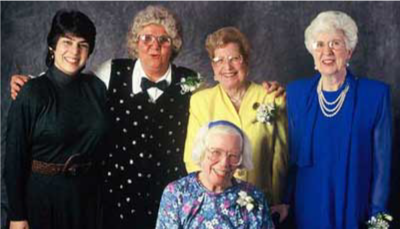
Kathy Kleiman, who rediscovered the ENIAC programmers, standing to the left of Jean Bartik, Marlyn Meltzer and Kay Antonelli. Betty Holberton is in front. Photo: ENIAC Programmers Project
They made strides for women in their later years, working to promote computing to young women and inspiring them with their stories. Imagine being told you can’t do maths and then working on thermonuclear bombs? Imagine being told your education will be a waste of time but end up creating the first user-friendly programming languages?
Their stories show how women can be tech pioneers but they also highlight the sexism that exists in the industry. The ENIAC women should be role models for programmers or anyone who wants to push boundaries and develop next generation technologies. And if you’re thinking about creating a tech startup, look no further than the ENIAC women for inspiration:
“I was told I’d never make VP rank because I was too outspoken. Maybe so, but I think men will always find an excuse for keeping women in their ‘place’. So, let’s make that place the executive suite and start more of our own companies.” — Jean Bartik
You can learn more about the ENIAC programmers at the website for the ENIAC Programmers Project.
This is the third article in a series about amazing women in tech history. The first featured Margaret Hamilton, the programming pioneer who helped land us on the moon. The second featured Grace Hopper, the programming pioneer who became the first woman to be a US Navy Admiral. The next is about Katherine Johnson, who calculated the trajectories that landed humans on the moon.
Women in tech history: Grace Hopper — Admiral, programmer, and rebel
This is the second article in a series about amazing women in tech history. The first featured Margaret Hamilton, the programming pioneer who helped land us on the moon.
The people who change the world are often the rebels; the people who see the world differently and try to push for a new future rather than staying in the past. Grace Hopper was one of those people and she most definitely left her mark on the world. Her life is a story of firsts and she was a pioneer in computer programming from the 1930s right through to the 1980s. That alone is enough of a reason to celebrate her as a woman in tech history but she was so much more. She was the Admiral, the pirate, the trouble-maker, and she was “Amazing Grace”.
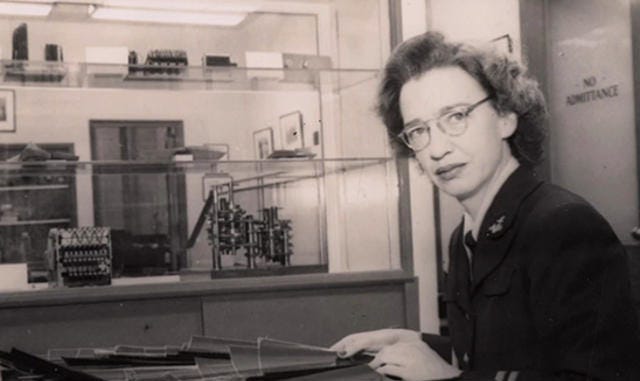
Tinkering toddler
Grace Hopper was born in 1906 in New York to parents of Scottish and Dutch heritage. Her father was a successful businessman and her mother was a housewife with a keen interest in maths. Grace was an exceptionally inquisitive child and played with anything that allowed her to build and disassemble, including construction kits meant for children much older than her. At the age of 7, she wanted to know how alarm clocks worked so she took apart 7 clocks before her mother realised what was going on. Her parents encouraged her natural curiosity and it was no surprise when she went on to study maths at university.
Grace obtained a bachelor’s degree in maths and physics at Vassar College before graduating with a master’s in maths from Yale in 1930. By 1934 she was the first woman to ever complete a maths PhD at Yale. Being first is a recurring theme in her life. Throughout the 1930s she taught maths and was an associate professor in 1941. At this time, the US was in the grip of World War II. The attack on Pearl Harbor was a turning point for Grace. She could have become a full professor at Vassar but she had somewhere else to be. In 1943 she chose to serve her country by volunteering for the Navy.
Bugs at Harvard
Grace volunteered for the women’s reserve in the Navy but almost didn’t get accepted as she was tiny, weighing 15 pounds less than the minimum weight. Fortunately she was exempted and graduated first from her training class, proving that they had made the right decision. She was made lieutenant and joined the Bureau of Ships Computation Project at Harvard University, where she quickly made her mark as a programmer on the Harvard Mark I computer. You’ve probably heard the story about a bug being found in an early computer; literally a moth. That was the Harvard Mark II and Grace popularised the terms “bug” and “debugging” as they’re used in computing.
“From then on, when anything went wrong with a computer, we said it had bugs in it.”
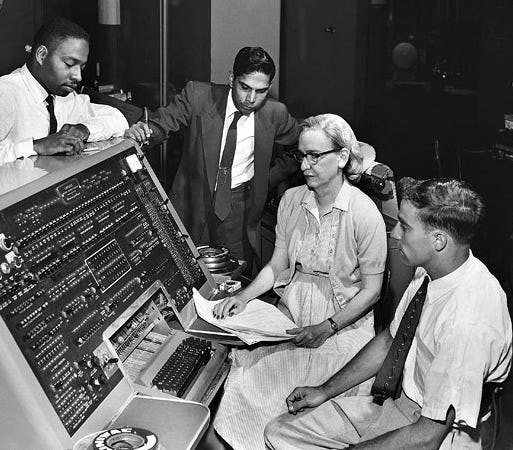
At Harvard she created one of her first important inventions: the subroutine, a single unit of program tasks that can be called upon and used repeatedly. Continuing to work on Navy projects, Grace joined the Eckert–Mauchly Computer Corporation in 1949 to work on the UNIVAC I computer. It was at this time that she made one of her greatest contributions to computing by inventing the compiler, a program that takes instructions written in a programming language and translates them into another language or the machine code that a processor can understand.
Compilers are a fundamental aspect of modern programming so it can’t be overstated how important this contribution is. At the time nobody could believe it had been done. It was considered a fruitless effort and that her time would be better spent working on other problems. That’s exactly the kind of response that would inspire Grace to press on anyway.
“Nobody believed it. I had a running compiler and nobody would touch it. They carefully told me, computers only do arithmetic; they could not do programs.”
Programming in English
The development of the compiler led Grace down a road that changed programming languages as we know them. She had a strong belief that programming didn’t have to be done in machine code and that more programming languages using plain English could make the field more accessible for everyone. She had created a programming language for the UNIVAC computers called FLOW-MATIC that used plain English and relied on her compiler to translate the language into something the computers could understand.
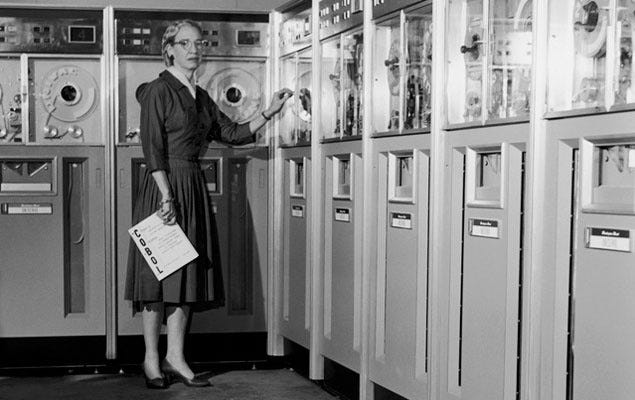
In 1959, she led a team of experts who modified her FLOW-MATIC language to create COBOL (Common Business-Oriented Language). It became the most common programming language for businesses and the US military due to its use of plain English and despite being 57 years old it’s still found in many business systems today. Modern languages are better, of course, so most of the current users are simply keeping older systems up and running. But it’s a testament to the the quality and vision of the project that it had such a lasting effect.
The Admiral
The Navy meant as much to Grace as programming and mathematics did. In 1966 she held the title of Commander but was forced to retire because she had reached the age of 60, which was standard practice. A year later they asked her back to work for just 6 months. Instead, she continued to serve for another 4 years before retiring again. History repeated itself and a year later she was asked back.
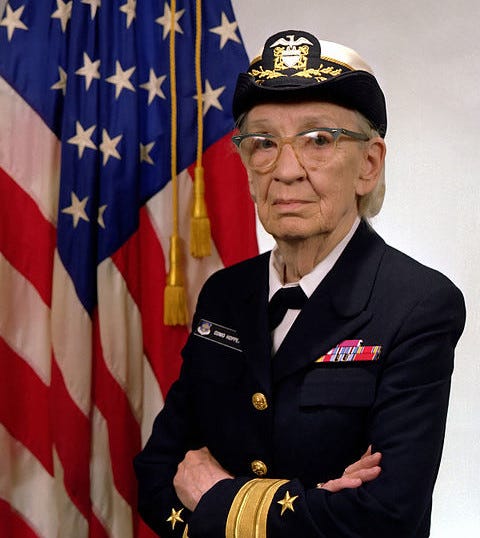
When she finally retired from the Navy for good, she was almost 80 years old, the oldest person actively serving, and the first woman to reach the rank of Admiral. Her retirement was celebrated on the USS Constitution and she received the highest decoration the Department of Defense can award for a non-combat role: the Defense Distinguished Service Medal. She worked as a consultant for another 5 years until her death.
Grace had a rebellious nature; this wasn’t because she enjoyed getting into trouble but because she wanted to change things when people told her it couldn’t be done. Biographer Jay Elliot wrote that she appeared all Navy, but inside there was “a pirate dying to be released.” Her rebellious nature is what helped her get things done. She wasn’t one to hide this aspect of her personality:
“Humans are allergic to change. They love to say, ‘we’ve always done it this way.’ I try to fight that. That’s why I have a clock on my wall that runs counter-clockwise.”
It’s obvious how respected she is in computing and in the Navy. She has a supercomputer and even an aircraft carrier named after her. Every year there’s a conference in her name that celebrates women in computing. She received over 40 honorary degrees from universities. Obviously her story is an inspiration to many. Not every programmer wants to work in the Navy; not everyone wants to write their own programming language; but she was an inspiration, not just for her achievements, but also her attitude:
The most important thing I’ve accomplished, other than building the compiler, is training young people. They come to me, you know, and say, ‘Do you think we can do this?’ I say, “Try it.” And I back ’em up. They need that. I keep track of them as they get older and I stir ’em up at intervals so they don’t forget to take chances.
Try it. Take chances. When others do, back ’em up.
This is the second article in a series about amazing women in tech history. The first was about Margaret Hamilton, the pioneering programmer who helped land us on the moon. The next is about the ENIAC women who were written out of history.
Women in tech history: Margaret Hamilton, the engineer who helped get us to the moon 🚀
This article is the first in a series about amazing women in tech history. The next is about Grace Hopper, the programming pioneer who was the first woman to become a US Navy Admiral.
Many of the early pioneers in programming were women. If this seems surprising, given that many tech-related industries can be hostile towards women, you should know that programming was once considered women’s work. In the early days of programming, computers read cards with holes punched in them as input. Punching holes into cards was seen as similar to typing, which was another job supposedly well-suited to women. Naturally, women thrived when given the opportunity and were among the early pioneers in programming that helped shape modern software development. One woman that immediately comes to mind, Margaret Hamilton, helped pioneer many aspects of modern programming and was instrumental in landing people on the moon.
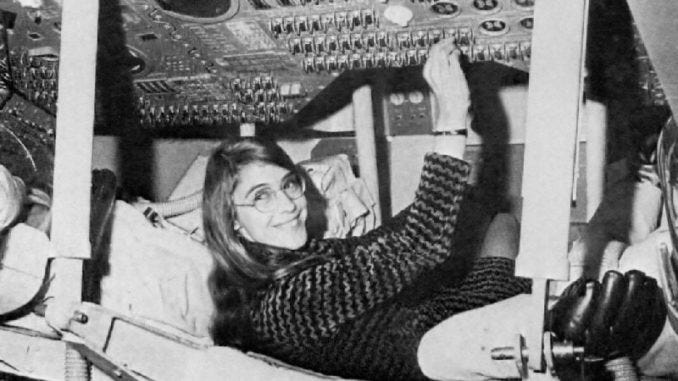
Margaret Hamilton studied maths at Earlham College, Indiana, in the 1950s. She taught for a while before moving to Boston with the goal of studying abstract mathematics but ended up joining MIT. There she began developing software to predict weather patterns. By “software” we of course mean bits of card with holes punched in them. The world was a very different place.
Back then it wasn’t a case of knowing the right programming language and turning up for the job. Computers were nothing like they are today, so the idea of a shared programming language that worked on them all was a long way off. At MIT, Hamilton used the LGP-30, a 340 kg computer that was weighed down so it didn’t move too much. Seriously. Programming was all about getting hands-on with these machines and figuring out how to get them to do the things you wanted them to. Take a look at the keyboard for this computer:

The Cold War and making a name for herself
In the early 1960s Hamilton worked on the SAGE Project, which began as weather prediction but was used by the military for anti-aircraft defence. Lincoln Labs, where she worked on this system, gave a difficult challenge to newcomers: they would test newbies by giving them a horribly confusing program that nobody else had gotten to work. The programming was complex, much was nonsensical, and all instructions and comments were written in Greek and Latin. You weren’t really expected to have any success but Hamilton became the first person to get the program to run.
Her achievements on the SAGE Project didn’t go unnoticed and she became the Director of software programming for NASA’s Apollo project that intended to land humans on the moon for the first time. Weather prediction? Done. Aircraft tracking? Done. Landing people on another world sounds like a reasonable next challenge, no?
One small step
Imagine that challenge. Today, you can learn computer science because people have worked on it before you. You can read textbooks and do exercises then walk up to pretty much any computer and make things happen. Back then computer science was barely a thing, at least in the academic sense. Hamilton was learning to program new computers as she went, laying the groundwork for future generations. She supervised her own team at NASA and developed the computers that would be used for guidance on the various spacecraft. The following image shows Hamilton standing beside the source code for the Apollo guidance computer.
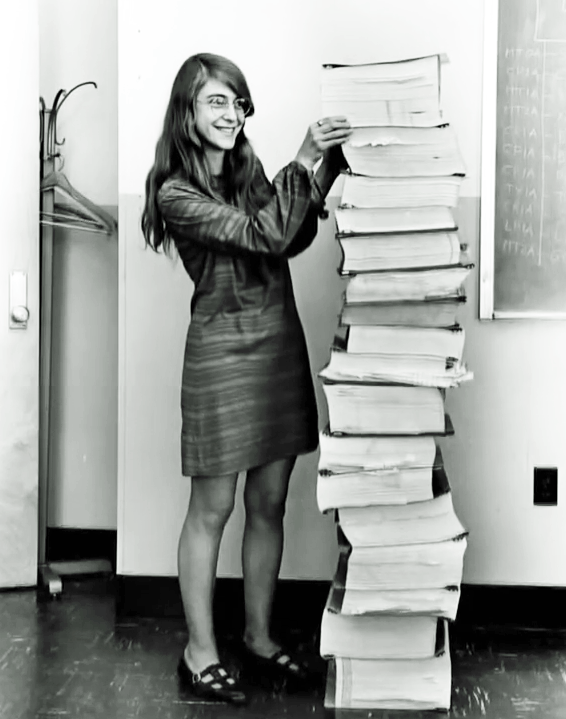
We can’t overstate the importance of her team’s software when it came to the successful moon landing. Obviously it would have been impossible without the guidance systems, but the coding actually prevented a mission-abort during the historic landing. If you’ve watched documentaries about Apollo 11, you’ve probably seen Mission Control panicking over the now famous 1202/1202 error that the astronauts encountered just 3 minutes before landing. At first people weren’t sure what it meant so they were considering aborting the mission. Armstrong and Aldrin nearly didn’t land on the moon.

A switch had been placed in the wrong position and the computer was having to keep track of this as well as the landing procedure. Back then the computers weren’t as resource efficient and it needed all the memory it could get just for the landing. The error indicated to Mission Control that the computer had too much going on and they were worried this would cause problems during the rest of the landing.
One of Hamilton’s many specialities was making her work robust. Her programs could work around problems rather than break down. Specifically, she is credited with developing priority scheduling, where the computer can drop less important tasks rather than give up altogether. The incident in her own words:
“Due to an error in the checklist manual, the rendezvous radar switch was placed in the wrong position. This caused it to send erroneous signals to the computer. The result was that the computer was being asked to perform all of its normal functions for landing while receiving an extra load of spurious data which used up 15% of its time.
The computer (or rather the software in it) was smart enough to recognize that it was being asked to perform more tasks than it should be performing. It then sent out an alarm, which meant to the astronaut, “I’m overloaded with more tasks than I should be doing at this time and I’m going to keep only the more important tasks; i.e., the ones needed for landing.”
Actually, the computer was programmed to do more than recognize error conditions. A complete set of recovery programs was incorporated into the software. The software’s action, in this case, was to eliminate lower priority tasks and re-establish the more important ones. If the computer hadn’t recognized this problem and taken recovery action, I doubt if Apollo 11 would have been the successful moon landing it was.” — Datamation, 1/3/1971
Hamilton ended up working on all the Apollo missions that landed astronauts on the moon. She played a major part in the development of modern programming, pioneering many aspects that we take for granted today. She did this at a time when software development was considered magic. Speaking to Verne, she described how people at the time viewed this type of work:
“Software during the early days of this project was treated like a stepchild and not taken as seriously as other engineering disciplines, such as hardware engineering; and it was regarded as an art and as magic, not a science.
I had always believed that both art and science were involved in its creation, but at that time most thought otherwise. Knowing this, I fought to bring the software legitimacy so that it (and those building it) would be given its due respect and thus I began to use the term “software engineering” to distinguish it from hardware and other kinds of engineering; yet, treat each type of engineering as part of the overall systems engineering process.
When I first started using this phrase, it was considered to be quite amusing. It was an ongoing joke for a long time. They liked to kid me about my radical ideas. Software eventually and necessarily gained the same respect as any other discipline.”
What amazes me is that Hamilton accomplished so much (like, you know, landing people on the moon) at a time when programming was shoving punch cards into a giant, whirring box until it did the thing it was supposed to. Although she’s probably most famous for her work during the 60s and her contributions to the Apollo missions, she didn’t slow down and went on to prove herself as a business owner. Today she is the CEO of Hamilton Technologies, Inc., which provides systems for companies including Motorola, IBM, NASA, the US Department of Defence, and the US Army.
This article was the first in a series featuring amazing women in tech history. The next is about Grace Hopper, a programming pioneer and the first woman to become a US Navy Admiral.
Who is the Blade Runner? 📽️
I’ve always known that there’s debate over whether Deckard is a replicant or not in the movie Blade Runner. I’ve never understood the debate because I feel the film spells it out pretty clearly. I figured some of the disagreement stems from people watching different versions of the film or the fact that some people just don’t pay much attention. I have friends who have movies as background entertainment, which is something I can’t do.
Today I was talking with a friend who had recently seen the best version (Final Cut, which is the true director’s cut) and they didn’t think Deckard was a replicant. So I explained why, in my opinion, he definitely is. I was surprised to find that two other friends, who also agree Deckard is a replicant, didn’t interpret the film the same way I did. I started asking my film friends online (ones I knew had seen the Final Cut) and none of them interpreted the film the same way I did.
I was a bit worried that I had read the film wrong. I took to Twitter and apparently only a small minority of followers seemed to know what I was talking about. So now I feel I have to dump these thoughts from my brain but I didn’t want to share all this in the Twitter thread because spoiling amazing films on social media isn’t a great idea. So here we go. Spoilers ahead. Seriously. Blade Runner (Final Cut) is a sci-fi masterpiece and really should be watched without spoilers so pleeeeeeeease watch it first before reading more. Here’s a nice picture before the spoilers begin.

Who is the “Blade Runner”?
The question “is Deckard a replicant or not” has always baffled me because it’s answered. To me the real question of the film that is eventually answered is “who is the Blade Runner?” I’ve always thought this was super obvious but the blade runner isn’t Deckard; it’s the ex-blade runner, Gaff. If you’ve forgotten who Gaff is, here’s a picture:
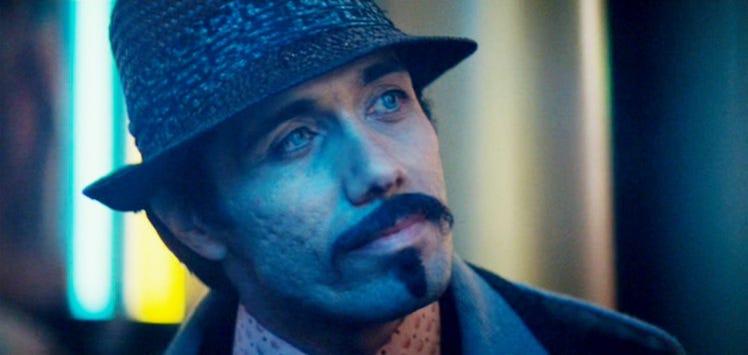
Yep, Gaff played by Edward James Olmos (also of Battlestar Galactica fame, so say we all). He is the super blade runner. The best there is. A legend. Let’s just be up front and tell you exactly what I thought was common knowledge by the end of the film: Gaff is the best blade runner but he’s getting older, he has a bad limp now and uses a cane, and just isn’t the “old blade runner” anymore.
What’s more, Tyrell can now create replicants who literally think they aren’t replicants by implanting them with the modified memories of real people. Rachel has the memories of Tyrell’s niece. I’m mostly ignoring the previous versions of the film but the original does mention that Gaff had been hanging around the Tyrell place and knew about Rachel. Of course he does. His memories have also been used in a replicant: Deckard.
“I need the old blade runner, I need your magic”
Blade Runner doesn’t have many characters who aren’t important to the plot. Sure there are extras roaming the streets but named characters with dialogue play an important part in the story. Except Gaff, apparently. He sits around and makes origami figures. But I think he’s the most important character in the film. The first time we see him he collects Deckard from a noodle bar. Unless Deckard has a tracker on it’s a bit weird that they find him there rather than his house or by calling him. Gaff knows where Deckard will be. This isn’t the last time Gaff appears to know what Deckard knows.
Next we see Gaff in the background as Deckard’s boss tries to give him an important assignment. Gaff doesn’t speak. He seems to have no role except to observe. It’s almost like he’s supervising. Or a backup if anything goes wrong with Deckard. I’m of the opinion that Gaff can still handle himself with a replicant. But four extremely dangerous models all at once? Sounds a bit much. When Deckard is refusing to take the assignment, Gaff knows he’s scared. Why? Because he’d be scared. Gaff knows Deckard better than anyone. That’s when he makes the first of his origami figures: a chicken. He also makes a man with a penis when Deckard is falling for Rachel and there’s the origami at the finale that we’ll get to. Is Gaff some kind of psychic?
There’s also a line from the boss that just stood out to me like a sore thumb. He seems excited and desperate to get Deckard on this case. Perhaps it’s a slip of the tongue but he says “I need the old blade runner, I need your magic”. Gaff, the best blade runner, isn’t his old self anymore. But with his memories in Deckard, maybe the old blade runner can be back in action?
“You’ve done a man’s job, sir!”
Gaff continues to keep an eye on Deckard, supervising him. It’s hard to know in the early stages of the film if this is a safety precaution in case Deckard figures out he’s a replicant or if Gaff is curious and sympathetic. But throughout we get hints that Gaff knows a creepy amount about Deckard. He knows where he’ll be, knows his emotions… and there are even more subtle clues but I won’t share too many because some could be coincidences. My favourite one that can’t be a real clue: I used to sell magic tricks for a living and the context I know the word “gaff” from is a gaff deck, a trick deck that looks like an ordinary deck of cards but is more than it seems. I’m sure it’s a coincidence rather than a hilariously clunky clue that the two characters are Gaff and DECKard!
But the film is full of hints that Deckard is a replicant. His journey through the film, discovering that Rachel is a replicant, reflects our own journey as viewers learning that Deckard is. We’re introduced to Gaff first. We’re then introduced to the idea that replicants can think they’re human. We learn about false memories (and in some versions that Gaff has some involvement with the people who do this). Deckard comes to sympathise with Rachel and learn that replicants can feel and be loved, and we’re simultaneously learning this about Deckard. A really cheeky moment is when Rachel asks Deckard if he’s ever been tested himself and he falls asleep before he can answer. And that is the answer. It’s right there. If you want to know for certain if all these hints mean anything you have to look at that answer: his sleep.
Deckard has a recurring dream of a unicorn. There aren’t other unicorns in his life that we’re aware of. As viewers we are privileged to see Deckard’s dreams and know something that nobody else in his universe can know. We’re literally seeing into his mind. He dreams of unicorns. We learn this information and store it for later.
At the excellent climax of the film, the first person Deckard sees after Batty dies is Gaff. The original version of the film was very heavy-handed with its narration and also clues. For the better versions they removed the narration and some of the dialogue that made the plot too obvious. One of my favourite removed lines was Gaff’s compliment to Deckard: “You’ve done a man’s job, sir!” Oh my god, what a loaded line. Sure, he’s done a good job. And a man’s job. As opposed to what, a replicant? And not just any man’s job, but a specific man’s job! It works in so many ways.
Origami
But even then nothing is really confirmed. Gaff is always around, always supervising dealings with Deckard, always knowing where he’ll be… but it doesn’t confirm anything. Perhaps Gaff just has intimate knowledge of newer blade runners for professional reasons. But by this point of the film we also don’t have a solid explanation for why Gaff makes a chicken figure when Deckard is scared or a man with a penis when Deckard is talking about Rachel. That’s a little too intimate. Does Gaff know what Deckard is thinking? Yes. He knows because it’s what he’s thinking. Nobody knows Deckard like Gaff does. Actually, he even knows what Deckard dreams about because they share the same memories and dreams.
Gaff chooses to warn Deckard at the end of the film. He warns him to save Rachel and perhaps even protects her because he was at the apartment at the very end of the film. Then the film drops its big reveal: Gaff leaves his final origami figure for Deckard to find. A unicorn. The thing Deckard sees in his dreams. Why Gaff chooses to help Deckard isn’t explained. Maybe he becomes sympathetic for Deckard just as Deckard does for Rachel. It should be no surprise that they come to the same conclusion about the lives of replicants given that they’re more or less the same person. Deckard saves Rachel and Gaff saves them both.
This is my favourite thing in the film. The dream is such a great misdirection. Halfway through the film we see the dream as proof that Deckard is human. It throws us off the scent. I mean, do androids dream of electric sheep? But by the end it’s literally the answer to the big question of whether Deckard is a replicant or not. That’s how I’ve always interpreted the film from the first time I saw it. I really can’t imagine seeing it any other way or Gaff would just be pointless. So there you go. I’m glad I got that out of my brain and onto the internet. I’m 100% positive others interpret the film the same way I do. They must do. But I’ve just been shocked at how many of my friends don’t see anything in Gaff when watching any of the versions including the Final Cut.
P.S.
I’m adding this short section just to address the reactions to this piece. I predicted I’d see a lot of people saying “oh wow yeah I know Deckard is a replicant but I never really thought about Gaff before except that he’s odd” and that is the most common reaction I’ve received. This piece is about Gaff, not about Deckard being a replicant. But I’m still getting reactions from people saying they think Deckard is a human and I’m not really understanding how they can explain that. You have another character aware of Deckard’s dreams. You have the director of the film confirming that Deckard is a replicant and that the unicorn is the reveal. And you have all the extra scenes that were cut because they would make it far too obvious. Try this alternative ending, for example:
“Did you know your wife for a long time?” is interesting because he answers “I thought I did”. It was actually Gaff that knew her. But more importantly this ending would make the very last lines of the film be: “We are made for each other”. That’s way too corny and heavy handed. I’m a big fan of how all the answers are in the film if you look for them but it’s much more subtle. I’m a huge fan of how making Deckard dream seemingly gives us proof he’s human early on and that someone else knows his dreams simultaneously shows he isn’t and makes the end of the film a callback to the title of Dick’s great book.
I think the real issue here is that Deckard is a human in the books and there’s a chance that Deckard may have been envisaged as a human in earlier versions of the film. I feel the character was always written to begin questioning it himself but in a subtle, vague way. So whether you think Deckard is human, or a replicant, or even perhaps the answer depends on the version you’re watching, you’re always supposed to at least have a suspicion and Deckard is always meant to have a vague sense of it regardless of the answer.
I’ve also had two reactions to the new film coming out. One is from people who feel Deckard is a replicant saying they were disappointed to see he’s still alive and that this is wrong or means they were wrong. The other reaction is from people who feel Deckard is a human, pointing to the new film as proof since he’s still alive. Remember, replicants live for four years.
So I hate to keep dragging you back to the original narrated version of the film because I don’t like how heavy handed it is but these are Deckard’s last narrated lines: “Gaff had been there, and let her live. Four years, he figured. He was wrong. Tyrell had told me Rachael was special. No termination date. I didn’t know how long we had together… Who does?”
Replicants live four years because they’re designed that way and you can’t change it or extend that life. But Rachel was designed to live longer. She’s special. She also differs from normal replicants in that she has the memories of a human (Tyrell’s niece). A replicant that has someone else’s memories and no forced termination date? Right there in the movies themselves? Maybe not so weird that Deckard is still alive in the latest film, huh?
Some thoughts and disagreements on The Matrix as a trans allegory 📽🏳️🌈
This post was originally published on Medium in 2017.
Late in 1999 I was feeling pretty lost. I had a good life by most measures but something was wrong. I’d felt it since childhood but when puberty hit, it went from “feeling different” to “the bad feeling”. Whenever I tried to bring it up with someone I was made to feel disgusting or broken. I’m transgender but back then I didn’t even know what to call it. Were there others like me? Was there something wrong with me? Few things seemed to help but distractions such as videogames and films allowed me to briefly escape my feelings. In late September 1999 I rented a new sci-fi action film everyone was talking about. I pushed the tape into my trusty VHS player, huddled up in bed, and watched The Matrix for the first time.
In Neo I immediately saw a reflection of myself but I didn’t immediately read much into it. When you’re trans it’s easy to find characters to identify with because the transgender experience is a very human experience. A lot of trans people find characters to relate to in Disney, simply because many of their stories handle identity and being your true self. I saw Neo feeling lost, knowing that something was up but not even knowing what to call it. He would stay awake for hours at night on his computer, searching for answers, wondering if anyone out there felt like he did. I thought “here’s a character who feels lost like me” but I didn’t read more into it than that. Then the next scene spoke to me too. And the next. I started to have an unsettling feeling that this film knew more about me than I did, much like Neo watching someone else’s words flash across his computer. “Knock knock”. I’ve related to characters in films before but I got an eerie sense that The Matrix was created just for me. My heart was racing when Neo finally met Morpheus. Imagine baby trans Jen taking this in:
“You’re here because you know something. What you know you can’t explain, but you feel it. You’ve felt it your entire life, that there’s something wrong with the world. You don’t know what it is, but it’s there, like a splinter in your mind, driving you mad.”
What if I told you (in my best Morpheus voice) that The Matrix is a trans allegory touching on themes such as denial and acceptance of gender identity; trans erasure in death; the diversity of transition experiences (not everyone uses hormone therapy, others even regret transitioning etc); and that trans activism and education are necessary if we want to live in a peaceful world?
In the words of Neo…

Art isn’t static
The Matrix was written and directed by two trans sisters, Lana and Lilly Wachowski, who have stated that trans themes appear in much of their work but nowhere as obviously as in The Matrix. When asked about fans looking back at the film, with new knowledge that both creators are trans women, Lana Wachowski once said that “art isn’t static”. I couldn’t agree more and this gets to the heart of why I want to write this piece.
Viewing art with a fresh pair of eyes can be like experiencing it for the first time all over again. Consider the many different perspectives people could have when viewing The Matrix. It’s obvious that a cisgender person (someone who isn’t trans - these are Latin prefixes), will likely interpret the film differently than a trans person would. Perhaps you may interpret the film differently before compared with after learning that the Wachowskis are trans women. That said, some people can’t see it at all:
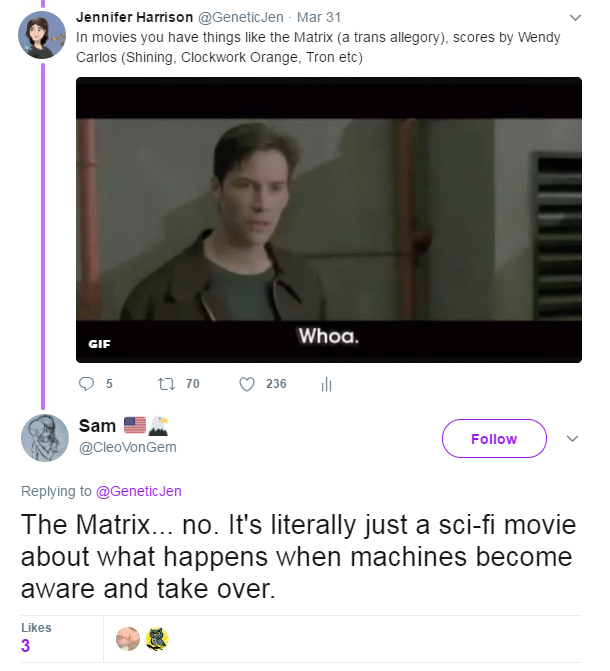
For me, always watching as a trans person, the interpretation of the film has evolved just as I have over the years. Art isn’t static. Of all the themes and metaphors you will read in this piece, I think I recognised about 25% of them during that very first viewing in my bedroom as baby trans Jen. I saw things that my friends didn’t, because they had no trans experience whatsoever. Over the years I’ve gleaned more and more from the film because of my own personal journey. As I grew up I learned trans terminology; I learned there were others like me; I learned about hormone replacement therapy; I learned about haters, chasers, and allies. As my own trans experience evolved, I noticed more of the trans allegory in scene after scene until the film became a living, breathing thing that changed alongside me.
Another reason for emptying these thoughts onto the internet is because I disagree, on many points, with others who have covered it before. I read some of the characters and scenes very differently. More importantly, I don’t think the trilogy has been given enough attention as a trans allegory. When viewed as generic sci-fi action films, the sequels really don’t do the original justice. As a trans allegory, however, they build on the original brilliantly and I think the people who miss the allegory also miss what makes the sequels interesting. Indeed, I believe many aspects of the sequels don’t make sense unless viewed as a trans allegory. I believe this is worth looking at closely and discussing further.
In order to share what I’ve taken from the film I need to provide a little perspective, so this piece necessarily has to touch on personal stories too. My goal is to give you some insight so that you (especially if you’re cisgender) can empathise and see why the film speaks to me and many other trans people. This might not be your average film analysis (actually it’s best to just consider this venting) but stick with me and and I’ll show you how deep the rabbit-hole goes.
Plugged into the cis-tem

Neo is obviously at the core of The Matrix. In the trans allegory, his journey to become “the One” is also his journey to become his true self. Whether you’re following the sci-fi plot or the trans allegory, Neo starts by knowing there’s something up, though he doesn’t know exactly what. There’s definitely more to his world. Then he comes to learn what he is by meeting other people who also felt the way he does. That doesn’t necessarily mean he accepts it or fully believes it himself. He has forces in his life that believe in him and others that threaten him, but through struggles Neo comes to accept himself and who he really is. This arc, taking Neo from discovering the truth to accepting his identity, takes place over the entire first film. The sequels handle the necessity of activism, the diversity of transitioning experiences, and peace.
“The Matrix is a system, Neo. That system is our enemy. But when you’re inside, you look around, what do you see? Businessmen, teachers, lawyers, carpenters. The very minds of the people we are trying to save.”
In the film, the matrix itself is one of two worlds or more accurately a world within a world. In the trans allegory, the matrix is simply how society sees gender. The matrix is cis-normative society. As Morpheus explains, that world or way of thinking is all around us. We see it on TV and we see it when we look out the window.
It’s no accident that the matrix was created by machines. It’s artificial. It’s a construct. All the humans living in the matrix are real biological beings trapped into thinking of gender in its most simplistic terms - not recognising trans people, and not recognising gender beyond the binary. Trans people break free from this system, which is represented in the film by our heroes being unplugged from the matrix itself.
“You have to understand, most of these people are not ready to be unplugged. And many of them are so inured, so hopelessly dependent on the system, that they will fight to protect it.”
Importantly, the cis people obliviously walking around in the Matrix are not the enemy; the system is the enemy. There are people out there who say that Black Lives Matters is anti-white, or feminism is anti-men, and that’s obviously bullshit. Similarly, being a trans allegory doesn’t make The Matrix anti-cis. In fact, the allegory paints cis people as victims in this system too and argues that — ultimately — peace comes from understanding and cooperation between trans and cis people.
“It is the world that has been pulled over your eyes to blind you from the truth.”
“What truth?”
“That you are a slave, Neo. Like everyone else you were born into bondage. Into a prison that you cannot taste or see or touch. A prison for your mind.”
The earliest scenes in the film are the most obvious, even to cis people. When Neo begins his journey he is given a choice between the red pill or the blue pill. Many trans people take pills as part of their hormone replacement therapy during transitioning. The fact that assholes online have accidentally co-opted the red pill from a trans allegory created by two trans women is both disappointing and unintentionally hilarious. Side-note: It’s important to note that some trans people don’t undergo hormone replacement therapy (HRT) and they are just as valid as trans people. The Wachowskis address this brilliantly in the sequels and anime projects through Kid, a character who wakes himself up from the matrix without the aid of any pills at all. In the allegory, he’s a trans person who accepts himself and transitions without HRT. He looks up to his trans heroes and he’s one of them without taking any pills. But I digress, we’ll get to the sequels another time.
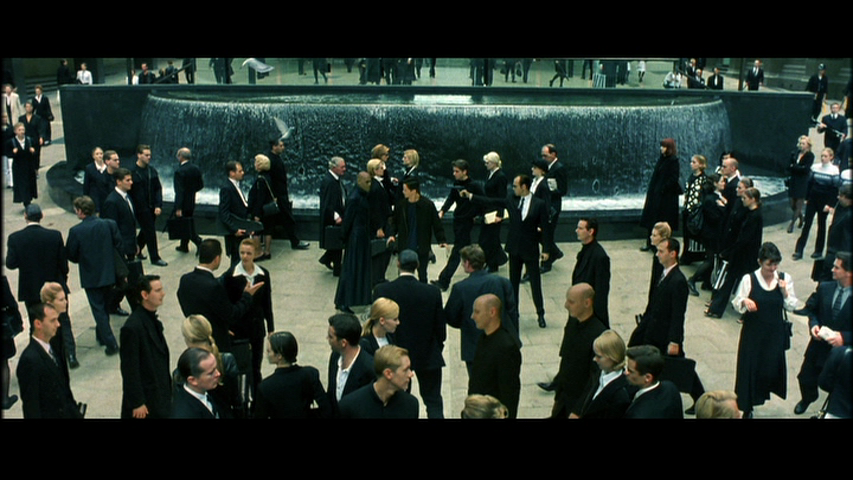
The Morpheus quotes I’ve been using come from a training scene where Neo learns about agents. It’s extremely powerful but I don’t believe it hits as hard for cis people. The agents are the real enemy. They’re a consequence of the system. They represent fear and hatred of the people unplugged. They’re the oppression of trans people. You can think of them as actual individuals in the sense of transphobic bigots but in the allegory they also represent that fear and hatred as a concept.
I’ve watched many films that openly feature trans people and no other has so accurately captured the feeling of walking down a busy street as a trans person. When I walk into town I know that most of the people around me are good, decent people. Most would probably come and help me if I was attacked or hurt. However, it’s also a fact that an alarming number are hostile to trans people. At best they might ridicule me; at worst they might try to murder me. The terrifying thing is that transphobes don’t have signs hovering above their heads. Until they actually attack, they look just like everyone else. They blend in. When you walk through a sea of people, you have no idea who could really be filled with that hatred, so you have to be ultra vigilant around everyone.
You don’t know who could be an agent.
Trans stories
Neo is the core of the trans allegory but the cast he meets are equally important. Some of them represent aspects of his own journey (especially Morpheus and Agent Smith, who we’ll come to) but other characters tell specific trans stories. There’s Switch, the only character who was specifically written as transgender. She’s the embodiment of the allegory; of being unplugged. Originally the role was to be performed by two actors, one male and one female, to give her a different body when inside or outside the matrix. The sci-fi aspect here is that there’s a glitch in the matrix that left her with a mental projection that doesn’t match her gender. (I’m going to continue using she/her pronouns for Switch because it’s canon now and you know who I’m talking about).

The production companies didn’t like this and had the Wachowskis play down the trans aspect and have the character performed by one actor. The Wachowskis compromised in several ways. Firstly, they hired an androgynous actor, which is probably the next best thing. Most importantly, they kept her character the same. We still know her as Switch, a name that references the switching between bodies as she plugs in and out of the matrix. She even keeps the white clothing while everyone else wears black; a visual queue to help viewers realise the two appearances in the original vision are the same character. Even better, she keeps her original dialogue. Her death scene isn’t exactly nonsensical, but it makes much more sense when you realise that the Wachowski’s engineered a scene in order to talk about trans erasure in death.
Many people come out to find that their relatives and loved ones are unsupportive or even hostile to trans people. It’s also a fact that a scary number of trans people die each year, sometimes from suicide or murder. Sadly, many of these unsupportive families erase the dead’s identity by deadnaming them and ignoring their transness. Obituaries and gravestones show deadnames. This is really common. In the allegory, the Wachowskis give these dead people a voice by engineering a situation where Switch knows she’s about to die. So there she is: back in the world she tried so hard to escape from, and in the body she tried so hard to escape from. Her last words might as well be those of all the trans people who have had their identity erased in death. “Not like this. Not like this.”
The biggest disagreement I have with others is over Cypher, who most people interpret as a chaser. I can see where this thought comes from as he hangs around the heroes, uses them, turns on them, and there’s clearly attraction involved with Trinity. I feel this oversimplifies one of the best characters in the film and a big part of the allegory. I think this view falls down when you consider that Cypher is unplugged, like the others, so he’s a trans person who has transitioned. The difference is that he’s unhappy. He’s jealous of others around him like Neo. And most importantly, he’s filled with regret. He doesn’t like this new world he finds himself in and wants to go back. Just as the sequels bring up more nuanced issues like transitioning without hormone therapy, the original film brings up the fact that there are people out there who wish to detransition.
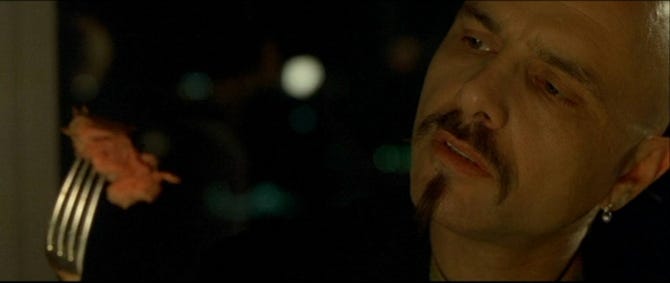
The most striking parallel with Cypher’s story and our world is that many people who detransition are used by transphobes in order to attack trans people further. People who detransition are seen as proof that there’s something wrong with being transgender or that society is forcing people to transition when they clearly don’t need to. Lo and behold, the agents use Cypher’s detransition back into the matrix to get to the heroes. They capitalise on his struggle. They appear as his allies but ultimately use him to deal a blow to the community he wishes to leave. We’re watching real-life play out on the Nebuchadnezzar.
The worst part of yourself
Not all agents are born equal and Agent Smith plays a special role in The Matrix as both a film and a trans allegory. He’s unique, even as an agent. He still represents fear and hatred of trans people as the other agents do, but for him it’s also self-hatred. As the Oracle eventually explains, Agent Smith and Neo are one and the same. They are flip sides of each other. Two halves of an equation. Equal yet opposite. Agent Smith is a failed “One” while Neo goes on to become successful. In the allegory, Neo eventually comes to accept his trans identity but Agent Smith does not. In some ways you can view Agent Smith as his own person, like a self-hating trans individual, but in almost every scene he also acts as a fearful, hateful aspect of Neo himself.
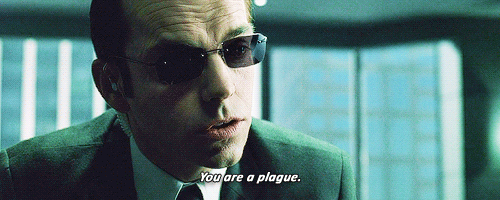
Being another agent, Smith always represents hostility towards trans people, but he clearly plays by his own rules and has his own purpose. Every action he takes represents Neo’s fear and doubt. Whenever he speaks to Neo, he deadnames him. Always Mr Anderson; never Neo. He captures and tortures Morpheus, who represents the hope and belief Neo has in himself (I’ll get to that). Agent Smith is the part of you that tries to keep you down, sow seeds of doubt, and tell you what isn’t possible. Your failure is inevitable.
Let’s step back from the film for a moment and talk about something that really happened. Content warning: contemplation of suicide. Years before filming The Matrix, Lana Wachowski hit an all-time low in terms of gender dysphoria and willingness to accept herself as trans. She decided to take her own life by walking down into a subway and jumping in front of an approaching train. She fought with herself and at the last moment changed her mind. Down there in the subway, she accepted her identity and from that moment knew she could live a genuine life as her true self. Facing your darkest self in a subway sounds familiar, no?
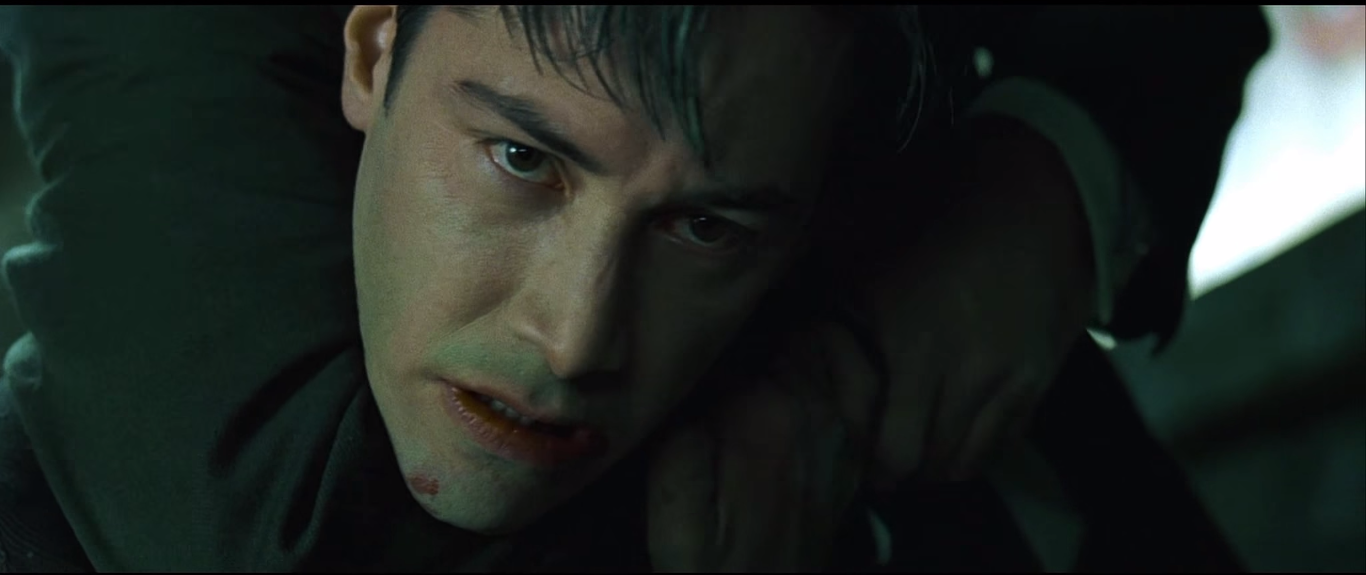
For my teenage friends, back in 1999, the subway scene was just another great moment of action; but for trans viewers it’s the emotional crux of the film. Neo is being hunted relentlessly by agents and comes face to face with Agent Smith, where he is pinned and appears doomed to be hit by the incoming train. Agent Smith, deadnaming Neo as usual, describes his death as inevitable. The train is coming and one way or another, “Mr Anderson” is going to die.
“My name… is Neo.”
Up until this moment Neo has been struggling to believe in himself and accept who he is. He clearly wants to believe but with so many forces against him it’s difficult. In this scene, like Lana Wachowski when she was in the real-life subway, Neo finds the bravery to fight for his life and begin accepting himself. As Morpheus says, “he’s beginning to believe”.

While Smith can be seen as the part of Neo that is self-hating and scared, Morpheus is the part that believes in himself. It’s no accident that many of the challenges Morpheus faces are from people who simply ridicule that belief. Just as in real life, transphobia comes in different forms. It’s true that trans people face violent hatred in the real world but we also face more subtle, casual transphobia and doubt from people close to us. Many attacks from transphobes are forms of emotional abuse. Some of the characters in this fictional universe aren’t violently aggressive towards Neo but they clearly have strong opinions about whether or not Morpheus is insane for believing in the One. I’m also often told I’m insane for being trans. If Agent Smith is the part of Neo trying to get him to give up, Morpheus is the part that knows the truth deep down. For me Morpheus represents belief either in yourself or belief and support from others. He picks you up when Smith knocks you down. This is an area where I disagree with others who have written about the trans allegory. Most writers see Morpheus as an older, wiser trans person who gives guidance. (If anyone plays that role I believe it’s the Oracle, who has some answers but insists you have your own story to understand). Agent Smith tells you that what you’re doing is impossible. Your failure is inevitable. When Smith is the voice saying you can’t do it, Morpheus is the voice saying you can.
Why do you persist?
When I started typing this piece I envisaged a well-structured article covering the entire trilogy. Instead it turned into this rambling outpouring of opinions mostly about the first film. I’m OK with that. I see personal pieces like this as entries in a diary of sorts. This is what I think about The Matrix. If anyone else gets something out of it then that’s cool. As a way for me to get my thoughts about the film out of my head, I’ve achieved my goal. I feel I’ve vented. I wanted to bring up a few aspects where I disagree with others and I did that. Mission accomplished. I feel better now.
That said, maybe you want more from this? Maybe I should really dive into the film properly? Maybe I should put my money where my mouth is and cover the continued trans allegory present in the sequels? Maybe. I’ll think about it. If there’s some demand, I could create a series of articles looking at each film individually. I am genuinely surprised that more people haven’t considered the sequels as continuations of the allegory. I’ve tried to watch them and focus on the sci-fi story alone, ignoring any hints of trans stories, and they’re really quite pointless. Perhaps I can help you enjoy them more by providing some of this context in a future entry, because both sequels are infinitely more rewarding when viewed through the lens of the trans experience.
Neo’s journey to become his true self is fantastic but so is his wider journey as an activist fighting for other trans people. I actually like the sequels and the direction they take the allegory. The first film finishes in the most perfect way for a continuation about becoming an activist and fighting for other trans people. When Neo talks directly to the machines at the end of the film, he’s talking directly to the hateful transphobes and people obsessed with enforcing the gender binary.
“I know that you’re afraid… you’re afraid of us. You’re afraid of change. I don’t know the future. I didn’t come here to tell you how this is going to end. I came here to tell you how it’s going to begin. I’m going to hang up this phone, and then I’m going to show these people what you don’t want them to see. I’m going to show them a world without you. A world without rules and controls, without borders or boundaries. A world where anything is possible. Where we go from there is a choice I leave to you.”

I’m not the biggest fan of action films but The Matrix means a lot to me. My friends tell me I’m brave just for being myself. I get death threats because of my gender. I’ve been assaulted for it. I’m violently hated by transphobes including some who stand against racism, homophobia, sexism etc. Every walk down the street requires extreme vigilance. Society seems determined to stop me, just like the forces standing against Neo. This is what makes him a brave hero for many trans people. He could take the easy way out at any opportunity but instead gets right back up every time he’s knocked down. In the climax of the third film, Agent Smith is sure he’s beaten Neo for good only to see him stand up once more. Agent Smith is the worst part of Neo. Deadnaming him again, Agent Smith asks the question that the worst part of me has asked myself far too often in the past:
“You must be able to see it, Mr. Anderson. You must know it by now. You can’t win. It’s pointless to keep fighting. Why, Mr. Anderson? Why? Why do you persist?”
“Because I choose to.”